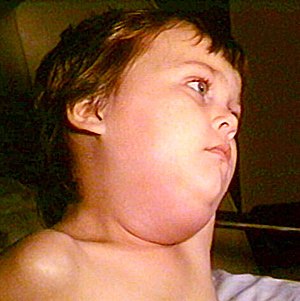MUMPS
| Mumps | |
|---|---|
 |
|
| Child with mumps | |
| Classification and external resources | |
| Specialty | Infectious disease |
| ICD-10 | B26 |
| ICD-9-CM | 072 |
| DiseasesDB | 8449 |
| MedlinePlus | 001557 |
| eMedicine | emerg/324 emerg/391 ped/1503 |
| Patient UK | Mumps |
| MeSH | D009107 |
Mumps, also known as epidemic parotitis, is a viral disease caused by the mumps virus. Initial signs and symptoms often include fever, muscle pain, headache, and feeling tired. This is then usually followed by painful swelling of one or both parotid salivary glands. Symptoms typically occur 16 to 18 days after exposure and resolve after seven to ten days. Symptoms in adults are often more severe than in children. About a third of people have mild or no symptoms. Complications may include infections of the covering of the brain (15 percent), pancreatitis (four percent), permanent deafness, and painful testicular swelling which uncommonly results in infertility. Women may develop ovarian swelling but this does not increase the risk of infertility.
Mumps is highly contagious and spreads rapidly among people living in close quarters. The virus is transmitted by respiratory droplets or direct contact with an infected person. Only humans get and spread the disease. People are infectious to each other from about seven days before the start of symptoms to about eight days after. Once an infection has run its course, a person is typically immune for life. Reinfection is possible but the ensuing infection tends to be mild. Diagnosis is usually suspected due to parotid swelling and can be confirmed by isolating the virus on a swab of the parotid duct. Testing for IgM antibodies in the blood is simple and may be useful; however, it can be falsely negative in those who have been immunized.
Mumps is preventable by two doses of the mumps vaccine. Most of the developed world includes it in their immunization programs, often in combination with measles, rubella, and varicella vaccine. Countries that have low immunization rates may see an increase in cases among older age groups and thus worse outcomes. There is no specific treatment. Efforts involve controlling symptoms with pain medication such as paracetamol (acetaminophen). Intravenous immunoglobulin may be useful in certain complications. Hospitalization may be required if meningitis or pancreatitis develops. About one per ten thousand people who are infected die.
...
Wikipedia
